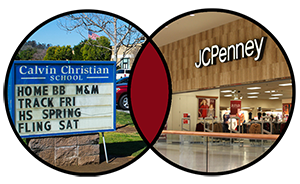I have posted several articles addressing the charter school movement (The Charters are Coming!; Can We Keep Up with the Competition?; Are You Spread Too Thin? How to Thrive and Not Merely Survive as a Christian School; and Leading Your School In Uncertain Economic Times: Practical Suggestions) because I see two major trends that have the potential to have a significant impact on our schools:
1) the rapid development of distance/online learning and
2) the growth of charter schools.
It is our responsibility as school leaders to anticipate the future and to steer our schools in the right direction to ensure that they remain relevant and vital.
The following Wall Street Journal article is important because it shows the growing acceptance and credibility of charter schools.
Charter Schools Pass Key Test in Study
![[Charter Club]](http://s.wsj.net/public/resources/images/NA-BA624A_CHART_NS_20090921190040.gif) By JOHN HECHINGER and IANTHE JEANNE DUGAN
By JOHN HECHINGER and IANTHE JEANNE DUGAN
WSJ September 2009
New York City students who win a lottery to enroll in charter schools outperform those who don't win spots and go on to attend traditional schools, according to new research to be released Tuesday.
The study, led by Stanford University economics Prof. Caroline Hoxby, is likely to fire up the movement to push states and school districts to expand charter schools -- one of the centerpieces of President Barack Obama's education strategy. (emphasis added)
Among students who had spent their academic careers in charter schools, the average eighth grader in Ms. Hoxby's study had a state mathematics test score of 680, compared with 650 for those in traditional schools. The tests are generally scored on a roughly 500 to 800 scale, with 650 representing proficiency.

Ms. Hoxby's study found that the charter-school students, who tend to come from poor and disadvantaged families, scored almost as well as students in the affluent Scarsdale school district in the suburbs north of the city. The English test results showed a similar pattern. The study also found students were more likely to earn a state Regents diploma, given to higher-achieving students, the longer they attended charter schools.
This year, the Renaissance Charter School in Queens and the Democracy Prep Charter School in Harlem each had 1,500 applicants for 80 seats. Rennaissance co-principal Stacey Gauthier says 90% of students achieve proficiency in the state test and end up going to college. "We have to perform well or we lose our charter," she says. "It makes us step up our game."
Randi Weingarten, president of the American Federation of Teachers, argued that New York City's charter schools aren't representative of the nation's, because the state caps charter schools and agencies vet them thoroughly before authorizing them, assuring they are of higher quality than elsewhere.
Charter schools are publicly funded schools, typically with nonunion teachers, that are granted more freedom by states in curriculum and hiring, and are often promoted as a way to turn around failing schools.
Critics of charter schools have long argued that any higher test scores were not necessarily attributable to anything the schools were doing, but to the students themselves, on the premise that only the most motivated students and families elected charters. Ms. Hoxby's study sought to address that argument by comparing students who attend charters directly with similarly motivated students -- those who sought to attend charters but were denied a seat through a random lottery. She concluded the charters did have a positive effect.
Charter supporters, including many conservatives, have often cited the school-choice research of Ms. Hoxby, a well-known economist who is also a fellow at Stanford's right-leaning Hoover Institution.
New York City's 99 charter schools are concentrated in poorer neighborhoods such as Harlem and the South Bronx. Some 30,000 students attend and another 40,000 are on waiting lists -- a small fraction of the 1.1 million students in the nation's largest school district.
Ms. Hoxby's study noted a strong correlation between achievement and charter programs with the following practices: a longer school day, merit pay for teachers and a disciplinary policy that punishes small infractions and rewards courtesy.
"We want to make New York City the Silicon Valley of charter schools," says schools Chancellor Joel Klein, who supports lifting statewide caps. "This study shows that when districts aren't antagonistic to charter schools, and instead welcome them, the results are very powerful."
But Ms. Weingarten, the union leader, cited another study this year from the Center for Research on Education Outcomes -- also at Stanford -- that looked at charters in 16 states and found that half did no better than traditional schools, and more than a third performed worse.
Pierina Arias, an Ecuadorean immigrant, turned to the Renaissance charter after her twins were rejected by a private school because they didn't speak English. "I was crying," says Ms. Arias. "I didn't know what to do." The twins won charter admission in a lottery, recently graduated with honors and are both in college, she says.
Patricia Hesselbach won a place in Democracy Prep's lottery for her 14-year-old daughter, Ayanna Mason, now a ninth grader. She had been at a traditional public school and needed to take outside courses to keep up with such basics as reading, her mother says. At Democracy Prep, Ms. Hasselbach says, her daughter is thriving. "They hold them to high expectations, and make sure they have discipline and dedication," Ms. Hesselbach says.
But Cynthia Lee, a hospital manager in Harlem, entered ten lotteries to get her 13-year-old daughter into Democracy Prep and didn't win a place. So, the single mother enrolled her daughter in a Catholic school for $3,100 a year. "I had no choice," she says. "I'd rather pay every last dime than put her in a public school."



![[Charter Club]](http://s.wsj.net/public/resources/images/NA-BA624A_CHART_NS_20090921190040.gif) By
By 